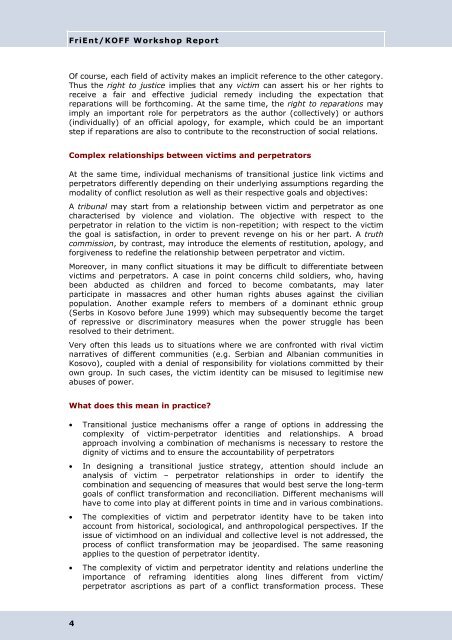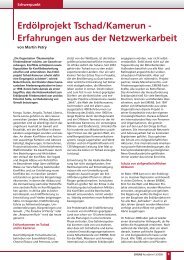Engaging with Victims and Perpetrators in Transitional ... - FriEnt
Engaging with Victims and Perpetrators in Transitional ... - FriEnt
Engaging with Victims and Perpetrators in Transitional ... - FriEnt
- No tags were found...
Create successful ePaper yourself
Turn your PDF publications into a flip-book with our unique Google optimized e-Paper software.
<strong>FriEnt</strong>/KOFF Workshop ReportOf course, each field of activity makes an implicit reference to the other category.Thus the right to justice implies that any victim can assert his or her rights toreceive a fair <strong>and</strong> effective judicial remedy <strong>in</strong>clud<strong>in</strong>g the expectation thatreparations will be forthcom<strong>in</strong>g. At the same time, the right to reparations mayimply an important role for perpetrators as the author (collectively) or authors(<strong>in</strong>dividually) of an official apology, for example, which could be an importantstep if reparations are also to contribute to the reconstruction of social relations.Complex relationships between victims <strong>and</strong> perpetratorsAt the same time, <strong>in</strong>dividual mechanisms of transitional justice l<strong>in</strong>k victims <strong>and</strong>perpetrators differently depend<strong>in</strong>g on their underly<strong>in</strong>g assumptions regard<strong>in</strong>g themodality of conflict resolution as well as their respective goals <strong>and</strong> objectives:A tribunal may start from a relationship between victim <strong>and</strong> perpetrator as onecharacterised by violence <strong>and</strong> violation. The objective <strong>with</strong> respect to theperpetrator <strong>in</strong> relation to the victim is non-repetition; <strong>with</strong> respect to the victimthe goal is satisfaction, <strong>in</strong> order to prevent revenge on his or her part. A truthcommission, by contrast, may <strong>in</strong>troduce the elements of restitution, apology, <strong>and</strong>forgiveness to redef<strong>in</strong>e the relationship between perpetrator <strong>and</strong> victim.Moreover, <strong>in</strong> many conflict situations it may be difficult to differentiate betweenvictims <strong>and</strong> perpetrators. A case <strong>in</strong> po<strong>in</strong>t concerns child soldiers, who, hav<strong>in</strong>gbeen abducted as children <strong>and</strong> forced to become combatants, may laterparticipate <strong>in</strong> massacres <strong>and</strong> other human rights abuses aga<strong>in</strong>st the civilianpopulation. Another example refers to members of a dom<strong>in</strong>ant ethnic group(Serbs <strong>in</strong> Kosovo before June 1999) which may subsequently become the targetof repressive or discrim<strong>in</strong>atory measures when the power struggle has beenresolved to their detriment.Very often this leads us to situations where we are confronted <strong>with</strong> rival victimnarratives of different communities (e.g. Serbian <strong>and</strong> Albanian communities <strong>in</strong>Kosovo), coupled <strong>with</strong> a denial of responsibility for violations committed by theirown group. In such cases, the victim identity can be misused to legitimise newabuses of power.What does this mean <strong>in</strong> practice?• <strong>Transitional</strong> justice mechanisms offer a range of options <strong>in</strong> address<strong>in</strong>g thecomplexity of victim-perpetrator identities <strong>and</strong> relationships. A broadapproach <strong>in</strong>volv<strong>in</strong>g a comb<strong>in</strong>ation of mechanisms is necessary to restore thedignity of victims <strong>and</strong> to ensure the accountability of perpetrators• In design<strong>in</strong>g a transitional justice strategy, attention should <strong>in</strong>clude ananalysis of victim – perpetrator relationships <strong>in</strong> order to identify thecomb<strong>in</strong>ation <strong>and</strong> sequenc<strong>in</strong>g of measures that would best serve the long-termgoals of conflict transformation <strong>and</strong> reconciliation. Different mechanisms willhave to come <strong>in</strong>to play at different po<strong>in</strong>ts <strong>in</strong> time <strong>and</strong> <strong>in</strong> various comb<strong>in</strong>ations.• The complexities of victim <strong>and</strong> perpetrator identity have to be taken <strong>in</strong>toaccount from historical, sociological, <strong>and</strong> anthropological perspectives. If theissue of victimhood on an <strong>in</strong>dividual <strong>and</strong> collective level is not addressed, theprocess of conflict transformation may be jeopardised. The same reason<strong>in</strong>gapplies to the question of perpetrator identity.• The complexity of victim <strong>and</strong> perpetrator identity <strong>and</strong> relations underl<strong>in</strong>e theimportance of refram<strong>in</strong>g identities along l<strong>in</strong>es different from victim/perpetrator ascriptions as part of a conflict transformation process. These4
















